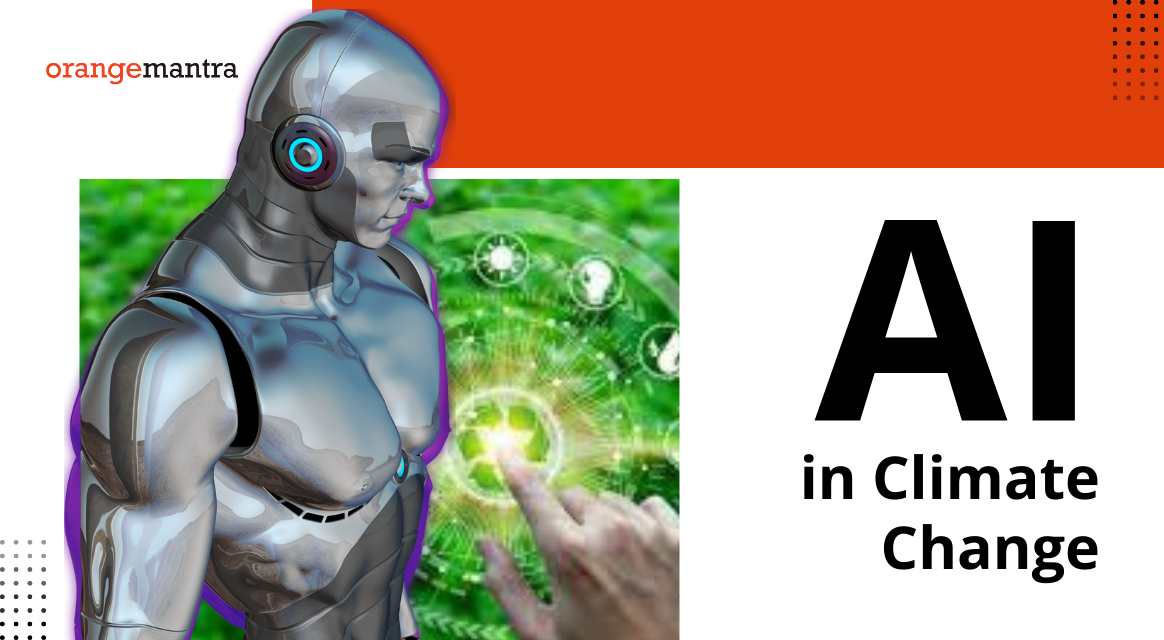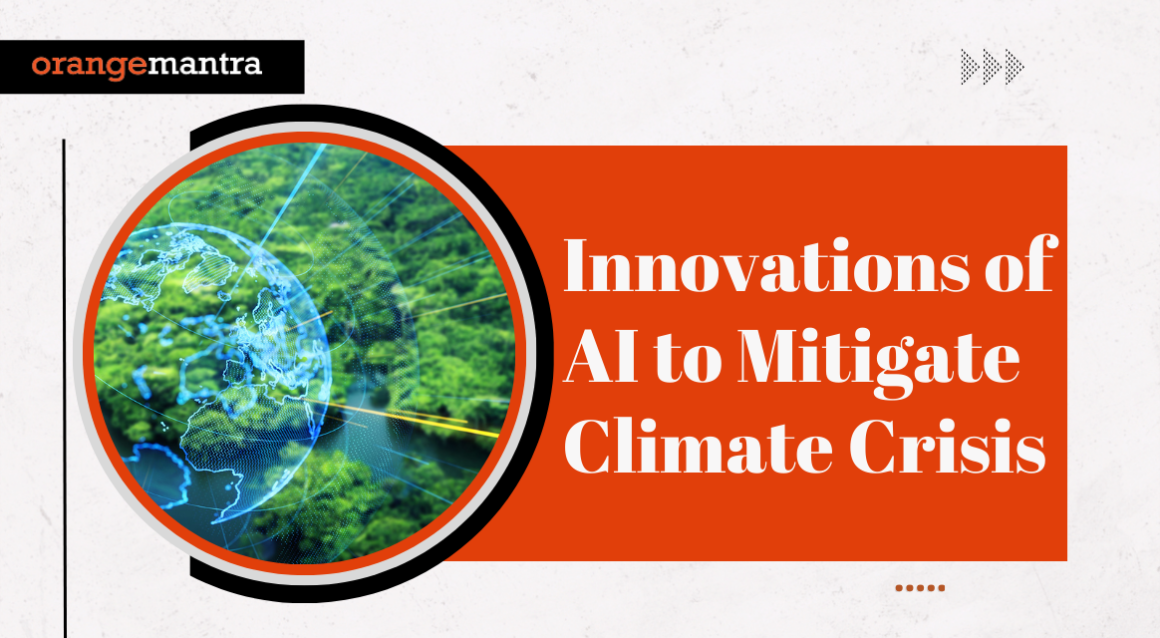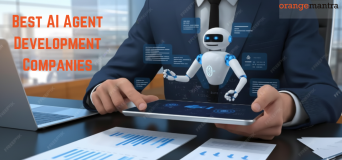
Here’s what you will learn:
Our planet is full of natural resources and a beautiful place to live. In the last few years, rapid growth has been observed in industrialization, and manufacturing units resulting in rising greenhouse emissions. As per reports, the earth’s temperature has increased by 1.2°C because of these emissions.
The changing climate has resulted in a major impact on environmental, social, and economic sectors. It is not hidden that the environment has experienced drastic impacts like longer droughts, destructive storms to forest fires.
Therefore it is critical to perform regular efforts to achieve net-zero emissions in the next few years. Technologies like AI are a catalyst to increase efforts and bring fruitful results. To manage complex issues, AI for climate change is the priority for experts. Being designed to gather, and interpret large datasets on emissions, and climate impact, it can be used to make informed decisions. Positive results of combating carbon emissions and building a greener society are already observed.
In this blog post, we will come across how AI can impact climate change and how it is building a sustainable world.
Read Also – AI in Education
Table of Contents
Innovations of AI to Mitigate Climate Crisis
1- Data Modeling and Prediction
Collecting and processing large volumes of climate data is a real challenge for concerned agencies. AI is a savior to model and predict climate patterns with complete accuracy. Modeling is about involves keeping a check on the complex interactions between different environmental factors like temperature, humidity, and atmospheric parameters. Traditional models bring no positive results in handling vast amounts of data. AI, and Machine Learning development services, excel when it comes to processing large datasets.
AI is helping experts to analyze historical climate data, satellite reports, and real-time sensor information. This functionality enables agencies to keep a check on extreme weather events, analyze climate risks, and build futuristic strategies.
2- Renewable Energy Management
The adoption of renewable energy is a major push of global efforts to tackle climate change. AI has a vital role to play in optimizing the efficiency and management of renewable energy resources. When we talk about technology solutions to climate change, AI-based algorithms can keep a check on the weather patterns to identify any changes in solar and wind power generation. Prediction of renewable energy production and power grids can help to lower dependency on fossil fuels and minimize the environmental impact.
Moreover, AI has been a strong addition to the technology behind the design and operation of power grids. These smart power grids manage the electricity flow, and load balancing, and seamlessly integrate renewable energy sources. The outcome is a sustainable energy infrastructure lowering greenhouse impact.
3- Monitoring and Assessment of Climate Change
Earlier it was difficult to make informed decisions with a traditional data collection approach. Monitoring and assessing the climate change impact is important to make futuristic decisions. AI technologies comprising remote sensing and satellite communication, are simplifying the process to keep a check on global data.
For example, AI is useful for processing images shared through satellites regarding deforestation, drought, floods, and changes in land use. This information is very much needed to make conservation efforts, natural resources management, and the existence of endangered species. With the availability of real-time information, AI assists strategists in implementing the best measures and addressing possible threats to the climate.
4- Sustainable Agriculture Measures
The agricultural sector has been impacted the most by climate change both in a positive and negative manner. AI development company is really helping to promote sustainable practices and ensure desired food production during the changing climatic conditions.
Sensors, drones, water dispensers, and data analytics are advanced technological innovations for climate change helping in crop management. Farmers can make data-driven decisions for improving irrigation processes, proper use of fertilization, and pest control to grow productivity. Once the waste is reduced, the outcome grows. AI is helping government agencies with food security measures while lowering the agriculture impact on the environment.
5- Climate Communication and Public Awareness
Doing regular and effective communication with the public brings awareness and support for climate action. AI can be implemented in social channels to create posts, trends, and viral videos and motivate public sentiment for climate change. By studying public perceptions and concerns, government agencies and authorities can modify strategies to engage audiences.
AI-powered bots and virtual assistants are also assisting in spreading crucial facts about climate change. These tools offer accessible and interactive platforms to learn about possible environmental concerns, energy-efficient measures, and ways to reduce fossil fuel consumption.
Read Also – How will AI solve world problems?
Challenges of Climate Change Mitigation
1. Global Support and Cooperation
The major challenge faced in addressing greenhouse impact on climate is the meaningful global support and cooperation. Every country has their own set of rules and policies to tackle climate change which is an ongoing hurdle. Inconsistent commitments and delayed implementation is creating alarming situation for the implementation of climate agreements.
2. Adoption of Renewable Energy
Making a shift from fossil fuels to renewable energy sources requires capital investment, political, and infrastructure development challenges. Many government agencies slow down the process due to lack of funds, resistance from vested interests and the time consumption process of renewable energy.
3. Limited Technologies
The existing landscape implemented by government agencies has limitations in terms of scalability and efficiency. Research and innovation are important to fix technology barriers and make important solutions easily implemented.
4. Depletion of Natural Resources
The increase in demand for resources results into deforestation, habitat loss, and negative impact on the biodiversity. Having sustainable resources at your end is important to keep a proper balance between human development and environment conservation.
Future Strategies of Climate Change Mitigation
1. Technology Advancements
With continuous advancements in next-gen technologies, particularly AI, brings numerous opportunities for climate data collection, renewable energy management, and sustainable agriculture. For instance, Artificial intelligence for climate change increase ability to understand and eliminate challenges effectively.
2. Improved Public Awareness
Focusing on improving public awareness can be possible with implementation of the sustainable practices and improving the policy decisions. Collective action is really important to push governments and businesses toward desired climate goals.
3. Nature-Based Solutions
When it comes to investing in climate change solutions, including reforestation and land management, can offer effective results. These available solutions are really required for the carbon elimination, biodiversity conservation, and the ecosystem restoration.
4. International Partnerships
In future, technology solutions to climate change requires strengthening international partnerships. This will bring agencies across the globe to provide collective effort to the climate change. With the presence of shared resources, data, and technology can help to bring some positive outcome for the climate action strategies.
AI Technologies for Climate Change Solutions
Artificial intelligence (AI) technologies has an important role in keeping a check on the climate change by providing best solutions. Here are a few AI technologies being used to mitigate climate change solutions:
-
Predictive Analytics
Machine Learning algorithms keep a check on large datasets to ensure climate models operate properly. It simply enhance and bring key insights to understand complex climate systems and even predict possible changes in an accurate manner. AI is an important technological innovation for climate change offering ensemble learning technique. This is used to improve the climate predictions accuracy by merging multiple models and considering different scenarios.
-
Renewable Energy Optimization
AI technology is a savior when it comes to predict production of the renewable energy depending on weather and other conditions. It can easily identify optimizing of solar and wind power integration within the grid. AI is really useful to manage and optimize the energy distribution within the smart grids resulting into minimum energy waste.
-
Energy Efficiency
Manual operation of controlling heating system, ventilation, and air conditioning systems is a real challenge for authorities. With availability of AI for climate change, it has become streamlined to optimize energy consumption. AI is important to assist in keeping a check on the energy demand patterns, assisting agencies to apply demand response strategies and lower down the energy consumption in case of peak hours.
-
Carbon Capture
Carbon emission is a serious concern for the environment and with AI it has become streamlined to optimize the emission work. Agencies can manage the storage processes, improve efficiency and lower operational costs. AI helps monitor and verify the effectiveness of carbon capture and storage initiatives through data analysis.
-
Climate Change Adaptation
Data analysis using AI technology provide early warnings when weather condition is extreme. This is useful for the communities to prepare and adapt. AI can help in the management of natural resources for eliminating any wastage. Water, agriculture, and forestry are all natural resources which need proper care when it comes to mitigate climate change.
-
Supply Chain Optimization
AI is playing a crucial role in managing the inventory to optimize supply chain operations. Once logistics is properly taken care it helps to reduce the carbon footprints and encouraging sustainable measures. AI helps to predict equipment failures, reduce downtime and resource wastage.
-
Economy Initiatives
Waste management is a real challenge for agencies across the globe. Several measures like promoting recycling and lowering environmental impact are in progress. AI has capabilities to analyze the environmental impact of products across their lifecycle. Any discrepancy identified is eliminated with the development of sustainable manufacturing measures.
With the above AI technologies implementations, business organizations and government agencies can build strategies to mitigate climate change. The availability of AI into different sectors can improve efficiency, lower resource usage, and assist in the transition process to bright future.
Conclusion
The best strategy to address climate change needs an innovative and effective process. AI works as a powerful tool to address complex challenges. Implementing AI technology for climate change, such as machine learning and deep learning algorithms, helps to improve climate modeling, make the best use of renewable energy production, and improve transportation systems.
AI technologies reduce the impact of climate change by providing relevant information on climate systems, renewable energy resources, improving energy efficiency, and more. These applications in the end contribute to more sustainable and transparent methods on a global scale.
Frequently Asked Questions
1. How does AI assist in addressing climate change?
AI is a real game changer in addressing climate change by offering advanced solutions across different domains. It can provide data insights, optimize renewable energy usage, enhance energy efficiency to mitigate climate change. For best results connect to an AI app development company for desired outcome.
2. Can AI predict and reduce the impact of extreme weather?
AI-powered algorithms can easily predict and mitigate the impact of extreme weather. Presence of Machine learning algorithms can be implemented to monitor large datasets to share early warnings, possible risks, and assist in building proper rescue plans.
3. Can you describe your AI application development process?
Our AI application development process is transparent and secure. It starts with the requirements gathering, design, development, testing, deployment, and maintenance work. Agile method is applied, allowing for flexibility and responsiveness during change requests. Client feedback is kept in mind during the development to ensure the final product meet expectations.
4. How do you perform project communication?
We employ robust project management techniques to guarantee streamlined communication. Regular status updates, sprint reviews, and multiple communication platforms like are available to keep our clients informed about the project status. We are open to communication at any time interval to address any concern.
5. How do you handle AI application development maintenance after deployment?
We assist our clients with real-time support beyond project completion. We provide ongoing maintenance to fix any possible issues, provide updates, and ensure the Ai application remains secure. This helps the client to prioritize core business activities while we fix technical aspects.



